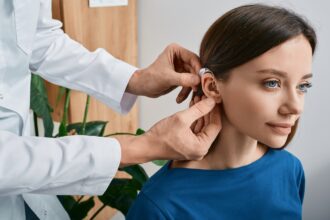Contact lenses have been a game-changer for people with visual impairments and what’s great about them is that they have made huge advancements in technology. The CDC estimates that around 45 million people wear contact lenses, because they find they have a lot of benefits over wearing glasses.
The benefits of contact lenses are significant. We previously mentioned that wearing contact lenses can make it easier to run, but the advantages don’t end there.
For example, the Dailies Total1 uses water gradient technology to keep the eyes hydrated, while the Acuvue Oasys contacts have UV-blocking capabilities to minimize the eye’s exposure to harmful UV light. And while they provide an alternative to glasses and are often more comfortable, they come with their own set of risks. One of the most significant risks associated with contact lens wear is sleeping in them. In this article, we will explore why you should never sleep in contacts.
Contacts and oxygen deprivation
The American Sleep Foundation reports that one of the main reasons why sleeping in contacts is harmful is the issue of oxygen deprivation. Contacts restrict the flow of oxygen to the cornea, which can lead to corneal swelling and, in severe cases, damage. When we sleep, our eyes receive less oxygen as it is, and adding contact lenses to the mix only exacerbates the problem.
Overnight wear can cause corneal abrasions
Contacts can scratch the cornea, especially if you sleep in them. Over time, these scratches can lead to corneal abrasions, which are painful and can cause permanent damage to the eye. This can be a major cause of vision loss. Additionally, sleeping in contacts can cause the lenses to dry out, which can cause them to stick to the eye’s surface and create friction, leading to further damage.
Infection risk increases with overnight wear
Sleeping in contacts increases the risk of eye infections, including bacterial and fungal infections. The cornea is highly susceptible to infections, and contact lenses provide an environment that is conducive to bacterial growth. Sleeping in contacts can cause bacteria to accumulate on the lenses, increasing the risk of infection.
Contacts can lead to conjunctivitis
Conjunctivitis, commonly known as pink eye, is an inflammation of the conjunctiva, the thin layer that covers the white part of the eye. Sleeping in contacts increases the risk of developing conjunctivitis. The lenses can trap bacteria, viruses, and other particles against the eye’s surface, causing irritation and inflammation.
Extended wear lenses are not a solution
Extended wear lenses are designed to be worn overnight, but they still pose risks. The longer you wear contact lenses, the more likely you are to develop complications. Extended wear lenses are associated with a higher risk of infection, corneal ulcers, and other complications. While they can be convenient, they are not a solution for sleeping in contacts.
How to reduce the risks of sleeping in contacts
If you wear contact lenses, it’s essential to follow proper hygiene and care guidelines. The American Optometric Association recommends removing contact lenses before going to bed, but if you must wear them overnight, follow these guidelines to reduce the risk of complications:
- Only wear contact lenses approved for overnight wear.
- Clean and disinfect lenses before sleeping in them.
- Use lubricating drops to prevent the lenses from drying out.
- Take regular breaks from contact lens wear to allow your eyes to breathe.
- Always wash your hands before handling contact lenses.
The bottom line?
Sleeping in contacts can cause a host of complications, including corneal swelling, corneal abrasions, infections, and conjunctivitis. While extended wear lenses may seem like a solution, they come with their own set of risks. Proper hygiene and care guidelines can help reduce the risk of complications, but the best course of action is to remove your contact lenses before going to bed. Protect your eye health by giving your eyes a break and sleeping without your contact lenses.








